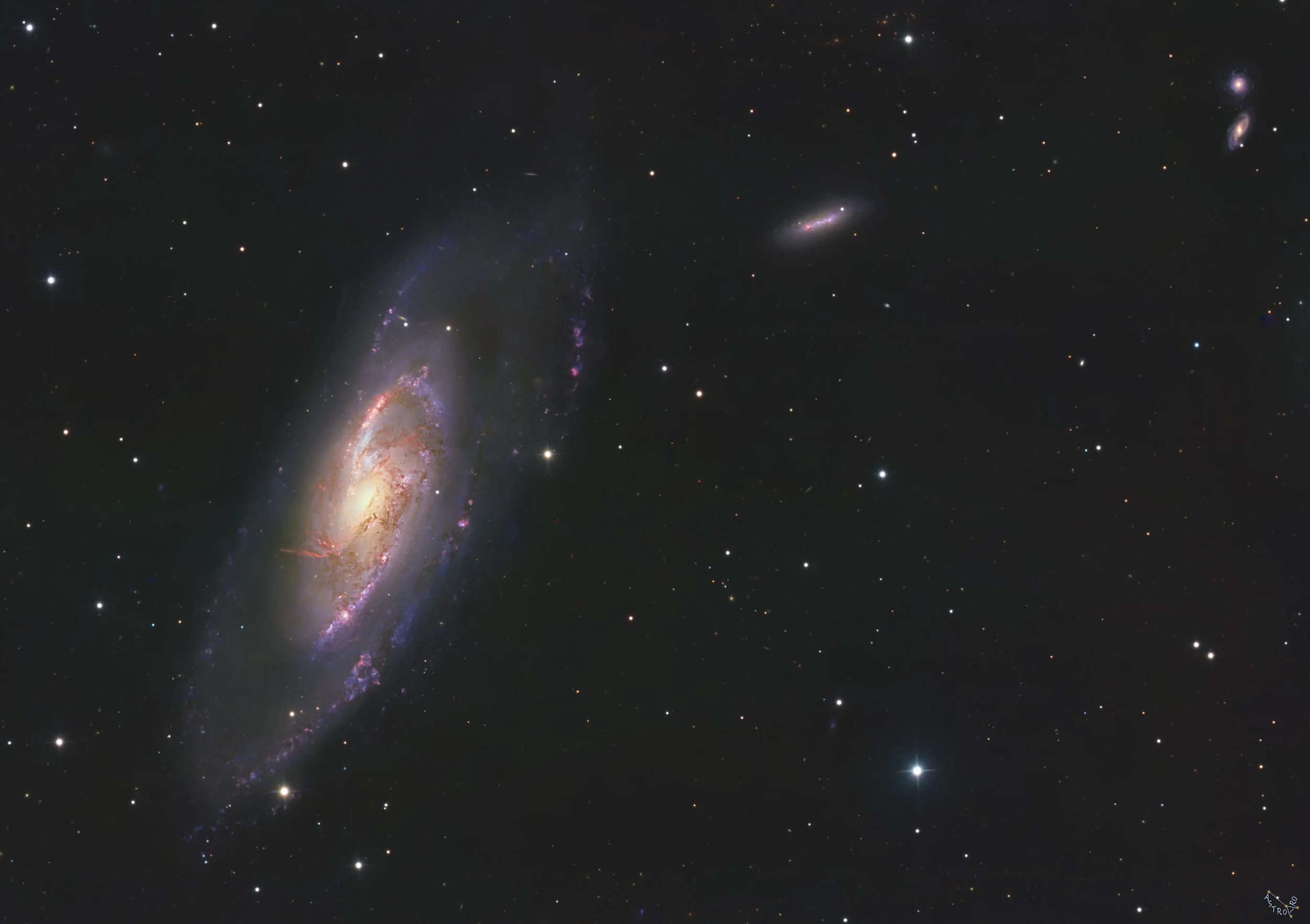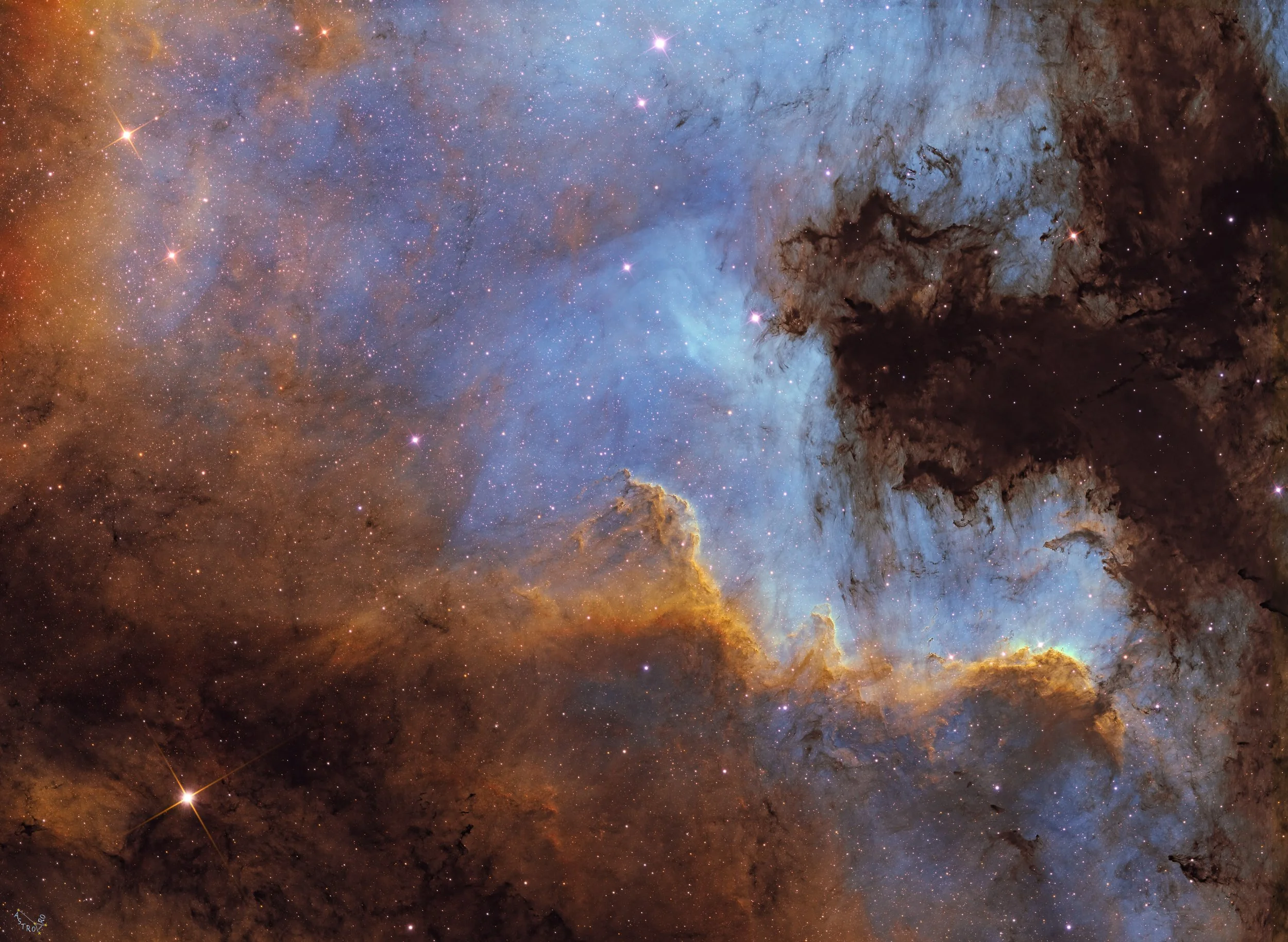
AAPOD2 Image Archives
M106 and the Canes II Group
Messier 106, a bright spiral galaxy in Canes Venatici, lies about 23 million light-years away and dominates the small local galaxy group known as Canes II. Its striking structure includes tightly wound spiral arms and a bright, active nucleus powered by a supermassive black hole. Radio and X-ray observations suggest that jets of material are being ejected perpendicular to the galaxy’s disk, producing faint wisps of emission often associated with Seyfert activity.
This deep image, captured from South Portugal, reveals several companion galaxies scattered across the frame, along with intricate dust lanes and a vivid galactic core. Taken using an Astrosib RC 400 on a DDM85 mount with a Moravian C4 CMOS camera, the final image combines precise tracking and post-processing using PixInsight and Photoshop to showcase the structure and surroundings of this energetic galaxy system.
M13: The Great Hercules Cluster in LRGB
Messier 13, also known as the Great Hercules Cluster, is one of the finest globular clusters visible from the Northern Hemisphere. Located approximately 22,000 light-years away in the constellation Hercules, this vast stellar swarm contains several hundred thousand stars packed into a region about 145 light-years across. Many of its stars are ancient, dating back over 11 billion years.
This deep LRGB image was captured over 17 hours and 50 minutes, revealing the dense, bright core and intricate halo of stars that extend outward into the surrounding field. Blue-tinged horizontal branch stars and cooler red giants are easily visible. The Great Cluster continues to be a popular target for both visual observation and astrophotography, showcasing the grandeur of stellar evolution in our galaxy’s halo.
Vdb 152
VdB 152, also known as the Wolf's Cave Nebula, is a stunning reflection nebula nestled in the constellation Cepheus, approximately 1,400 light-years away. This delicate structure appears as a faint, bluish glow caused by starlight reflecting off surrounding interstellar dust. The nebula is part of a dense molecular cloud that obscures the light from background stars, creating a dramatic interplay of light and shadow.
Captured from southern Portugal over 24 hours in LRVB, Hα, and OIII, this long exposure reveals the nebula's faint, ethereal features. Intricate filaments of hydrogen-alpha and oxygen-III emissions enhance the view, showcasing regions of subtle ionization and interstellar activity. The nickname "Wolf's Cave" evokes its mysterious, enclosed appearance, where light seems to emerge from the darkness, illustrating the quiet beauty of cosmic processes shaping the galaxy.
Ngc 4565
NGC 4565, often referred to as the "Needle Galaxy," is a remarkable edge-on spiral galaxy situated in the constellation Coma Berenices. One of its lesser-known facts is that it hosts a dense central bulge, which contains a supermassive black hole that emits powerful X-rays as it interacts with surrounding matter. This galaxy is also famous for its prominent dust lane that spans its length, expertly made visible in this image, partially obscuring the galactic disk and adding to its distinctive appearance.
The Cygnus Wall
In a remarkable celestial portrait, the Cygnus Wall unveiled its stunning grandeur within the North America Nebula (NGC 7000). This colossal structure, resembling a jagged and intricate wall of gas and dust, bore witness to the relentless forces of star formation and stellar winds. Energetic young stars nestled within this cosmic tapestry emitted intense radiation, sculpting the wall's mesmerizing contours and cavities. The Cygnus Wall served as an astronomical canvas, illustrating the awe-inspiring interplay between the luminous processes of star-birth and the cosmic architecture that emerges from these dynamic stellar interactions.
M27
Image Description and Details : The Dumbbell Nebula is a planetary nebula located in the constellation Vulpecula at about 1227 light years. It was discovered by Charles Messier on 12 July 1764 and is the first observed planetary nebula in the history of astronomy. It is number 27 in his catalogue.
This object is particularly bright and has a very large apparent diameter, with the brightest part being 1/5 that of the Moon. With an expansion rate of 6.8 arcseconds per century, its age is estimated at 3 000 to 4 000 years.
The central star (the origin of the nebula) has an apparent magnitude of 13.5, which makes it difficult for an amateur astronomer to observe. It is a white dwarf with a very hot blue colour (85 000 K).
The peculiar shape of the luminous part of the nebula has earned it the name Dumbbell Nebula.
Looking at this nebula, we can see the end of our own solar system in 5 billion years.
Photo taken in South Portugal in Remote de France by the ARO team, from
04/08 to 28/09/22.
Set-Up: Astrosib RC 400 (F/D 8) on DDM 85 ASA mount. Camera Moravian G3 16200.
52 Hours in H,O,L,R,G,B
Copyright: Team ARO
Ngc 2024 Flame Nebula
Image Description and Details : Flame Nebula (Ngc 2024) made by Team ARO in South Portugal . This Team is composed of Francis Bozon, Jean_Luc Gangloff, Stéphane Gueyraud.The Flame Nebula extends over about 12 light years. Alnitak (Zeta Orionis), the easternmost bright star in Orion's belt, energises the nebula. The intense ultraviolet radiation from this blue supergiant ionises the hydrogen atoms in the nebula.Gas and especially dust in front of NGC 2024 absorb the light from the nebula and form the dark ribbon seen in the visible light images.These acquisitions were made with Scope Fsq 106, on Eq6 Pro and ZWO Asi 1600MM camera. The exposure times are as follows:-Ha= 201 x 180''-R = 73 x 150 ''-V = 92 x 120 ''-B= 94 x 120 ''That is a total time of about 19.15 hours.
Copyright: Francis Bozon / Team Aro
Léo Trio
Image Description and Details :
The Leo Trio is a small cluster of interacting galaxies located about 35 million light years from Earth.On the left-hand side of the image, the near-vertical bar with a thin band of black dust represents the galaxy NGC 3628, magnitude 9.5, seen from the edge. It is also known as the Hamburger Galaxy.Messier objects M 65 (NGC 3623), magnitude 9.3, below the upper right-hand corner, and M 66 (NGC 3627), magnitude 8.9, to the left of the lower right-hand corner, are tilted enough for their spiral arms to be visible.This image was taken in Perche-Normandy France.The total acquisition time is 5h15 in L,R,G,B.The image was taken with a Newton 250-900 telescope (F/D 4), Moravian G2 4000 camera on EQ8 Skywatcher mount
Copyright: Francis Bozon
Sh2-132 HOO
Image Description and Details :
Sh2-132 in HOOrvb made by Team AstroNew in France in the region of Normandy (Perche) and in Lorraine (côtes de Meuse) . This Team is composed of Francis Bozon, Stéphane Gueyraud.Sh2-132 is a large emission nebula visible in the constellation of Cepheus. It is located on the southern edge of the constellation, on the border with the constellation Lacerta, along the plane of the Milky Way.These acquisitions were made with Newton telescopes (250-900 F/D 3,6), on Eq8 mount and Moravian G2 4000 camera.The exposure times are as follows:Ha= 53X20'O3=50X20' Red= 9x5'Green =23x5'Blue=15x5'That is a total time of about 38,25 hours.
Copyright: Francis Bozon, Stéphane Gueyraud
Sh2-224
Image Description and Details :
Sh2-224 in HOOlrvb made by Team ARO (astroaro.fr website) in Southern Portugal, Dark Sky Alqueva area. Francis Bozon, Jean-Luc Gangloff, Stéphane Gueyraud. Sh2-224 is a very weak supernova slash in the constellation of the Auriga, with an unusual shape.The acquisition of this photo was made with a Fsq 106 scope on ArEq6 Pro mount and Asi 1600MM camera.
The exposure times are as follows:Ha= 219X300''S2=112x300''O3=179X300''Luminance= 19x60''Red= 21x90''Green =20x60''Blue=23x60''That is a total time of about 33 hours
Copyright: TEAM ARO (Francis Bozon, Jean-Luc Gangloff, Stéphane Gueyraud.)
Ngc 4236
Image Description and Details :
Galaxy NGC 4236 in the Dragon constellation, created with two totally identical setups, from two different sites: the first one in the West of France in Normandy and the other one in the East of France in Lorraine.-Telescopes: Newton Skyvision MTN 250-300 f/d 3.6-EQ8 Skywatcher frames-Moravian G2 4000 Cameras-Optical Divider: SkymecaSelf-steering cameras: Lodestar and Atik 314L-Chroma FiltersPROCESSING: Pixinsight and PhotoshopAcquisition:Lum:129x5'.Red:44x5'.Green:39x5'.Blue:41x5'.Ha=20x20'.Total=27h74
Copyright Information: Francis Bozon Stéphane Gueyraud











